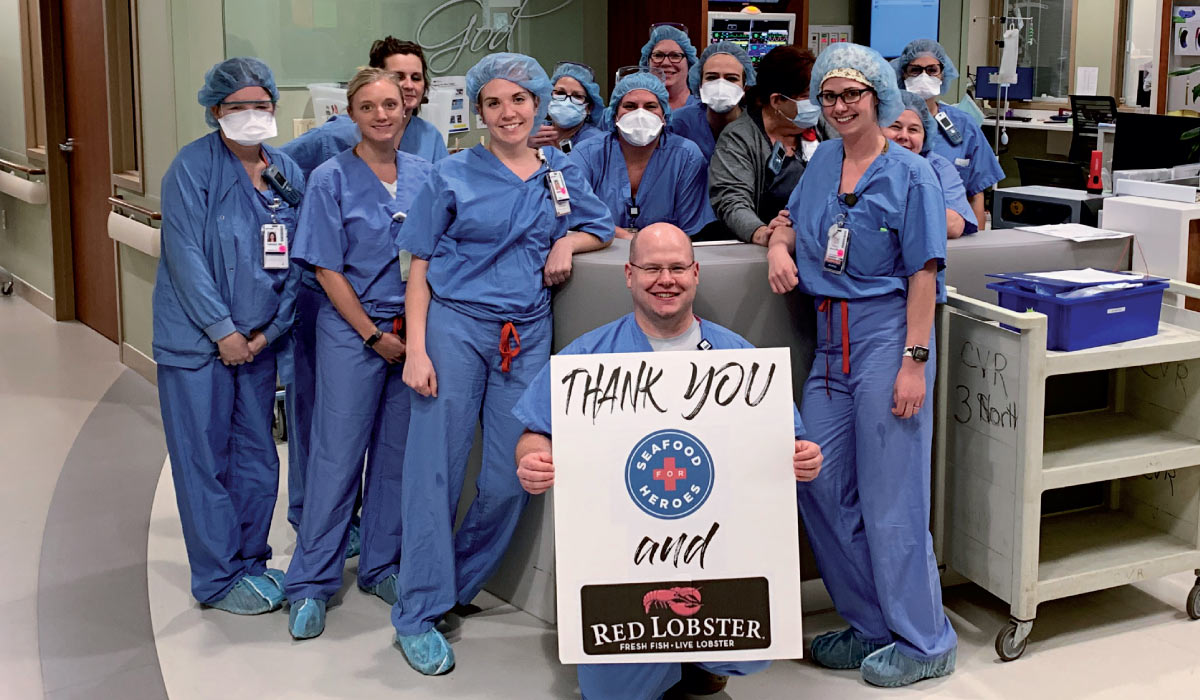When the coronavirus hit the U.S., the Napa Seafood Foundation mobilized its resources and partners to serve those on the front lines in a matter of days.
“The first week was spent internally and externally organizing, and the second week was a soft launch,” says Larry Cotter, the foundation’s chairman of the board. “By the third week, we had served 7,500 meals to first responders in 44 cities and 13 states.”
The Napa Seafood Foundation, a nonprofit focusing on philanthropic and community development through seafood, started the initiative, called Seafood for Heroes, in April with the goal of delivering protein-rich meals to healthcare workers across the U.S. That goal was brought to fruition by the foundation’s funds and the food prep and delivery of various national and local restaurant partners. Napa Seafood Foundation compensates the restaurants for their labor and food costs, and then those partners manage the logistics of getting those meals to first responders.
Seafood giant Red Lobster was one of the earliest of these partners, bringing a restaurant network that allowed Seafood for Heroes to rapidly reach hospitals and medical centers across the country. The brand piloted the initiative in the Southeast, but within a couple weeks, it pushed into various other regions in the Red Lobster system.
At press time, Seafood for Heroes had served 10,000 meals to healthcare workers in more than 48 cities. And those behind the program aren’t planning on stopping anytime soon.
FSR spoke with Cotter, as well as Red Lobster’s Southeastern vice president of operations, Ingrid Hebel, and its mid-South vice president of operations, Kara Ramirez, about the goals behind Seafood for Heroes, serving others when your own industry is in crisis, and potentially continuing the meals when dining rooms fully reopen.
How did Seafood for Heroes get off the ground?
Larry Cotter: We spent a couple weeks working out details, but by the third week, we were going full speed. When we were putting this all together, some hurdles immediately showed up in my mind. But, in the end, it all became very simple; the restaurant partners are in charge of preparing the meals, taking the meals to the hospitals, and contacting the hospitals in advance. We are responsible for raising money.
Gathering donors and partners is an ongoing process, but we’ve been amping up our social media outreach. And our board members have been calling and emailing different companies and contacts. My personal goal is to provide at least 100,000 meals. Each meal costs $10 each, so we need to raise around $1 million.
Why did Red Lobster choose to participate in Seafood for Heroes?
Ingrid Hebel: Red Lobster is one of the largest seafood companies in the world, and we participate in a lot of industry events, including the Napa Seafood Summit, hosted by the foundation. So we felt we were a natural partner. I think that everyone has felt a little helpless lately, and this program gave our people a bright spot, because they felt like they could help. People rally behind causes like these.
Kara Ramirez: During times like these, everyone wants to contribute their own special skills. This is what we do; we provide great seafood and great food. This gives us an opportunity to provide our special skills in a way that helps others.
What’s really great about this program is that our operators are the ones coordinating the meal delivery. So they can plan how they handle it differently—they can deliver during off-peak hours if that helps them. This is an important initiative and, with the proper planning, it’s really easy to execute, and it really makes our team feel good about what they do.
Are there any messages about the seafood industry or Red Lobster that you hope Seafood for Heroes will help spread?
LC: This is a win-win-win all around. First responders win because they get good meals. Partnering restaurants win because they have another revenue flow, and they get to keep employees working. And the seafood industry wins because, ideally, people are going to remember the value and quality of what they are eating and pay attention to our industry in the future.
IH: Usually people remember who treated them well during a crisis. That’s not why we’re doing this—this is just the right thing to do. But maybe someone who hasn’t visited Red Lobster or who hasn’t been in a while takes a look at what we have to offer. Most of all, I hope they remember our great food and friendly people.
Will this program continue once restaurants are open again?
KR: We are reopening for dining gradually and after careful consideration and implementation of additional health and safety procedures and guidelines from the Centers for Disease Control and Prevention and government mandates, as well as recommendations by the National Restaurant Association. We will continue to evaluate the program as we reopen.
IH: It’s important to get the word out about the fundraising side of this. As long as people are contributing to the cause, we want to continue delivering the meals.








